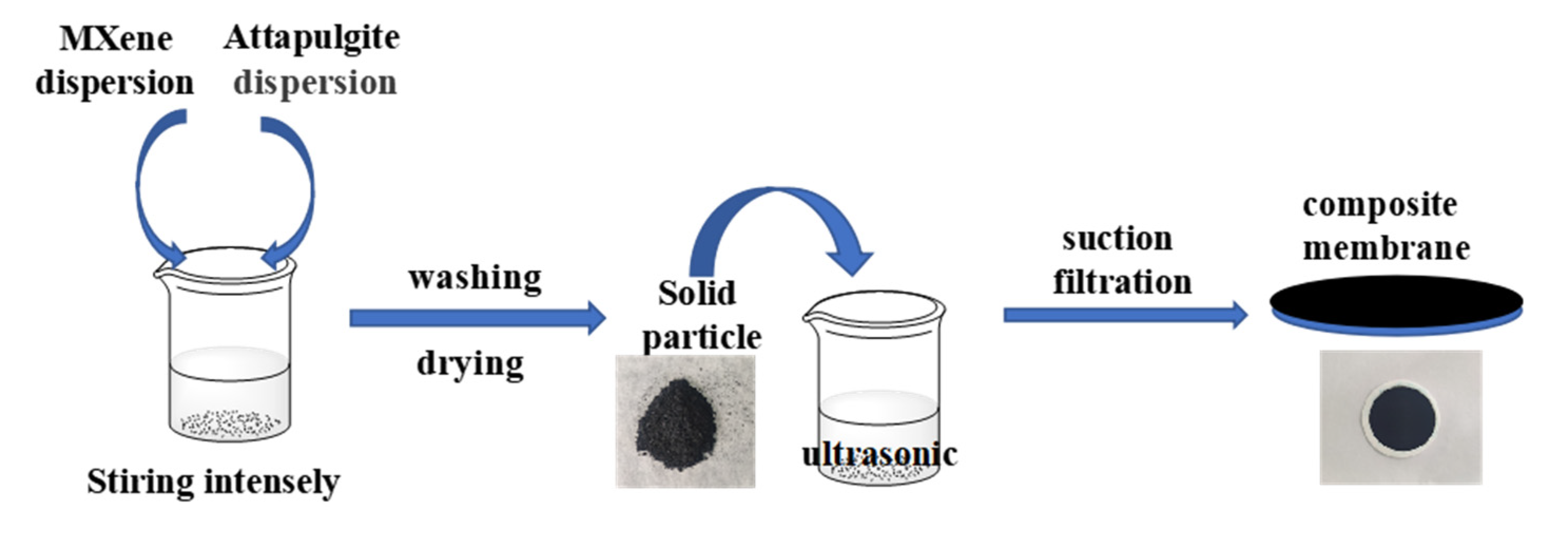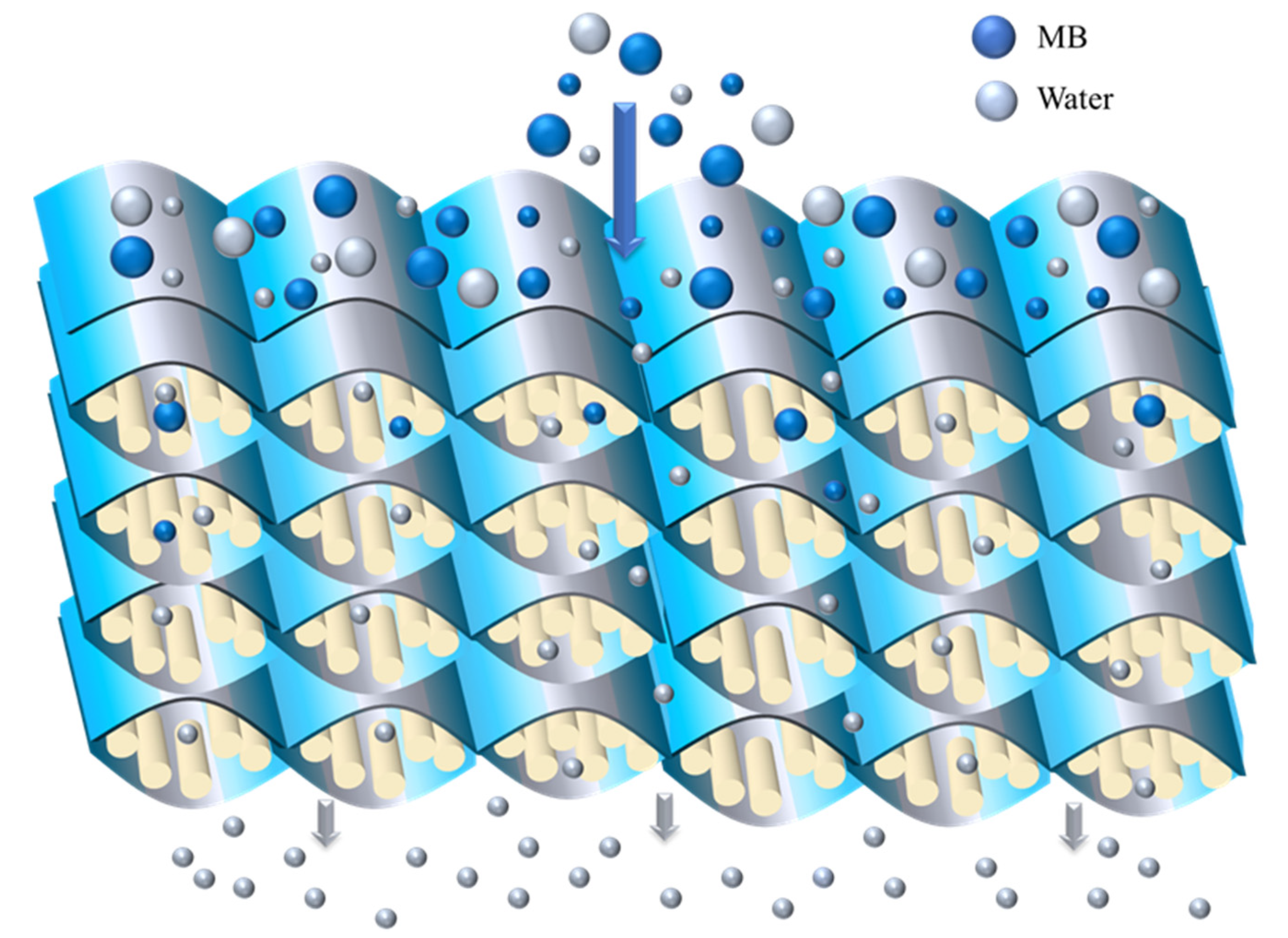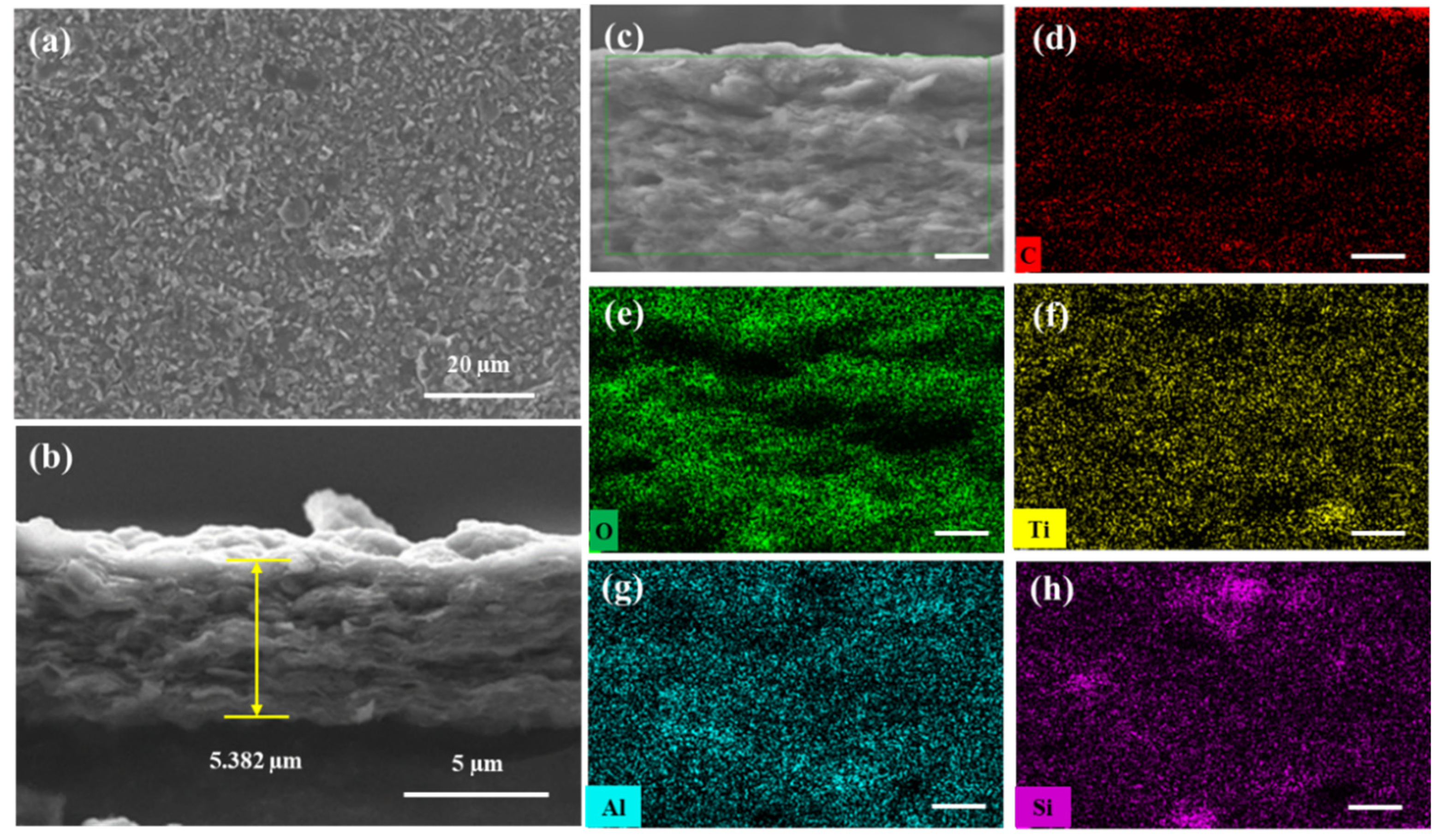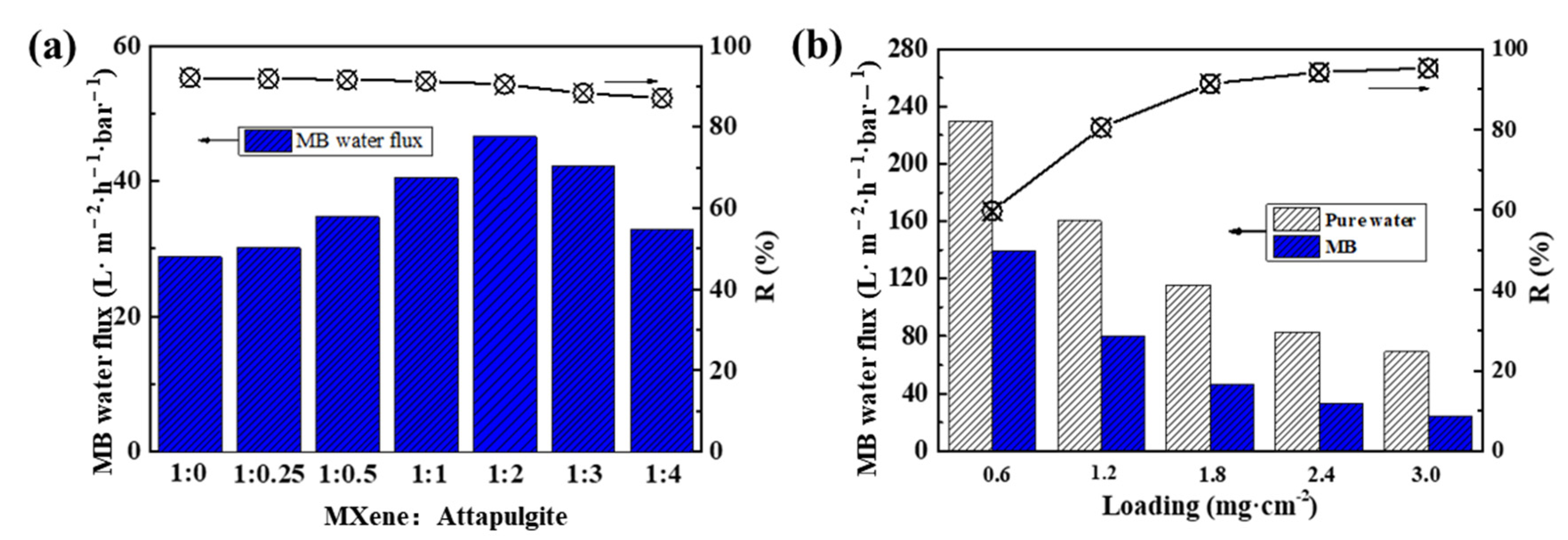Attapulgite Nanorods Incorporated MXene Lamellar Membranes for Enhanced Decontamination of Dye Wastewater
Abstract
:1. Introduction
2. Materials and Methods
2.1. Materials
2.2. Preparation of MXene Nanosheets
2.3. Purification of the Attapulgite
2.4. Preparation of MXene/Attapulgite Composite Membranes
2.5. Characterization
2.6. Experimental Method
3. Results and Discussion
3.1. Morphological, Structural and Chemical Characterization of MXene/Attapulgite Composites
3.2. Morphological, Structural and Chemical Characterization of MXene/Attapulgite Composite Membranes
3.3. Separation Performance of MXene/Attapulgite Composite Membranes
4. Conclusions
Author Contributions
Funding
Institutional Review Board Statement
Informed Consent Statement
Data Availability Statement
Conflicts of Interest
References
- Naguib, M.; Kurtoglu, M.; Presser, V.; Lu, J.; Niu, J.; Min, H.; Hultman, L.; Gogotsi, Y. Two-Dimensional Nanocrystals Produced by Exfoliation of Ti3AlC2. Adv. Mater. 2011, 2, 4248–4253. [Google Scholar] [CrossRef]
- Wan, S.; Li, X.; Wang, Y.; Chen, Y.; Xie, X.; Yang, R.; Tomsia, A.; Jiang, L.; Cheng, Q. Strong sequentially bridged MXene sheets. Proc. Natl. Acad. Sci. USA 2020, 117, 27154–27161. [Google Scholar] [CrossRef]
- Liu, G.; Shen, J.; Liu, Q.; Liu, G.; Xiong, J.; Yang, J.; Jin, W. Ultrathin two-dimensional MXene membrane for pervaporation desalination. J. Membr. Sci. 2018, 548, 548–558. [Google Scholar] [CrossRef]
- Ren, C.; Hatzell, K.; Alhabeb, M.; Zheng, L.; Gogotsi, Y. Charge- and Size-Selective Ion Sieving through Ti3C2Tx MXene Membranes. J. Phys. Chem. Lett. 2015, 6, 4026–4031. [Google Scholar] [CrossRef] [PubMed]
- Ihsanullah, I. Potential of MXenes in Water Desalination: Current Status and Perspectives. Nano-Micro Lett. 2020, 12, 72. [Google Scholar] [CrossRef]
- Lu, Z.; Wei, Y.; Deng, J.; Ding, L.; Wang, H. Self-Crosslinked MXene (Ti3C2Tx) Membranes with Good Antiswelling Property for Monovalent Metal Ion Exclusion. ACS Nano 2019, 13, 10535–10544. [Google Scholar] [CrossRef] [PubMed]
- Wei, L.; Deng, W.; Li, S.; Wu, Z.; Cai, J.; Luo, J. Sandwich-like chitosan porous carbon Spheres/MXene composite with high specific capacitance and rate performance for supercapacitors. J. Bioresour. Bioprod. 2022, 7, 63–72. [Google Scholar] [CrossRef]
- Gao, Y.; Wang, L.; Zhou, A.; Li, Z.; Chen, J.; Bala, H.; Hu, Q.; Cao, X. Hydrothermal synthesis of TiO2/Ti3C2 nanocomposites with enhanced photocatalytic activity. Mater. Lett. 2015, 150, 62–64. [Google Scholar] [CrossRef]
- Zhang, S.; Liao, S.; Qi, F.; Liu, R.; Xiao, T.; Hu, J.; Li, K.; Wang, R.; Min, Y. Direct deposition of two-dimensional MXene nanosheets on commercially available filter for fast and efficient dye removal. Hazard Mater. 2020, 384, 121367. [Google Scholar] [CrossRef]
- Pandey, R.; Rasool, K.; Madhavan, V.; Aïssa, B.; Gogotsi, Y.; Mahmoud, K. Ultrahigh-flux and fouling-resistant membranes based on layered silver/MXene (Ti3C2Tx) nanosheets. J. Mater. Chem. A 2018, 6, 3522–3533. [Google Scholar] [CrossRef]
- Ding, L.; Wei, Y.; Wang, Y.; Chen, H.; Caro, J.; Wang, H. A Two-Dimensional Lamellar Membrane: MXene Nanosheet Stacks. Angew. Chem. Int. Edit. 2017, 56, 1825–1829. [Google Scholar] [CrossRef]
- Das, R. Two-Dimensional (2D) Nanomaterial in Separation Science; Springer Nature: London, UK, 2021. [Google Scholar]
- Liu, T.; Liu, X.; Graham, N.; Yu, W.; Sun, K. Two-dimensional MXene incorporated graphene oxide composite membrane with enhanced water purification performance. J. Membr. Sci. 2020, 593, 117431. [Google Scholar] [CrossRef]
- Long, Q.; Zhao, S.; Chen, J.; Zhang, Z.; Qi, G.; Liu, Z. Self-assembly enabled nano-intercalation for stable high-performance MXene membranes. J. Membr. Sci. 2021, 635, 119464. [Google Scholar] [CrossRef]
- Huang, R.; Lin, Q.; Zhong, Q.; Zhang, X.; Wen, X.; Luo, H. Removal of Cd(II) and Pb(II) from aqueous solution by modified attapulgite clay. Arab. J. Chem. 2020, 13, 4994–5008. [Google Scholar] [CrossRef]
- Fan, Z.; Zhou, S.; Mao, H.; Li, M.; Xue, A.; Zhao, Y.; Xing, W. A novel ceramic microfiltration membrane fabricated by anthurium andraeanum-like attapulgite nanofibers for high-efficiency oil-in-water emulsions separation. J. Membr. Sci. 2021, 630, 119291. [Google Scholar] [CrossRef]
- Dong, S.; Li, B.; Zhang, J.; Wang, A. Superamphiphobic Coatings with Low Sliding Angles from Attapulgite/Carbon Composites. Adv. Mater. Interfaces 2018, 5, 1701520. [Google Scholar] [CrossRef]
- Yuan, B.; Yin, X.; Liu, X.; Li, X.; Sun, L. Enhanced Hydrothermal Stability and Catalytic Performance of HKUST-1 by Incorporating Carboxyl-Functionalized Attapulgite. ACS Appl. Mater. Interfaces 2016, 8, 16457–16464. [Google Scholar] [CrossRef] [PubMed]
- Zhao, X.; Su, Y.; Liu, Y.; Jiang, Z. Free-Standing Graphene Oxide-Palygorskite Nanohybrid Membrane for Oil/Water Separation. ACS Appl. Mater. Interfaces 2016, 8, 8247–8256. [Google Scholar] [CrossRef] [PubMed]
- Wang, C.; Zeng, W.; Jiang, T.; Chen, X.; Zhang, X. Incorporating attapulgite nanorods into graphene oxide nanofiltration membranes for efficient dyes wastewater treatment. Sep. Purif. Technol. 2019, 214, 21–30. [Google Scholar] [CrossRef]
- Naguib, M.; Mashtalir, O.; Carle, J.; Presser, V.; Lu, J.; Hultman, L.; Gogotsi, Y.; Barsoum, M. Two-Dimensional Transition Metal Carbides. ACS Nano 2012, 6, 1322–1331. [Google Scholar] [CrossRef] [PubMed]
- Shi, J.; Li, M. Surface modification effects in phase change material-infiltrated attapulgite. Mater. Chem. Phys. 2020, 254, 123521. [Google Scholar] [CrossRef]
- Zhang, X.; Tian, J.; Wang, P.; Liu, T.; Ahmad, M.; Zhang, T.; Guo, J.; Xiao, H.; Song, J. Highly-efficient nitrogen self-doped biochar for versatile dyes’ removal prepared from soybean cake via a simple dualtemplating approach and associated thermodynamics. J. Clean. Prod. 2022, 332, 130069. [Google Scholar] [CrossRef]
- Li, J.; Xu, C.; Zhang, Y.; Wang, R.; Zha, F.; Shea, H. Robust superhydrophobic attapulgite coated polyurethane sponge for efficient immiscible oil/water mixture and emulsion separation. J. Mater. Chem. A 2016, 4, 15546–15553. [Google Scholar] [CrossRef]
- Dong, S.; Li, S.; Li, Z.; Zhang, L.; Yin, L. Mesoporous Hollow Sb/ZnS@ C Core–Shell Heterostructures as Anodes for High-Performance Sodium-Ion Batteries. Small 2018, 14, 1704517. [Google Scholar] [CrossRef]
- Xing, R.; Pan, F.; Zhao, J.; Cao, K.; Gao, C.; Yang, S.; Liu, G.; Wu, H.; Jiang, Z. Enhancing the permeation selectivity of sodium alginate membrane by incorporating attapulgite nanorods for ethanol dehydration. RSC Adv. 2016, 6, 14381–14392. [Google Scholar] [CrossRef]
- Li, M.; Zhou, S.; Xue, A.; Su, T.; Zhang, Y.; Zhao, Y.; Xing, W. Fabrication of porous attapulgite hollow fiber membranes for liquid filtration. Mater. Lett. 2015, 161, 132–135. [Google Scholar] [CrossRef]
- Chang, C.; Nie, X.; Li, X.; Tao, P.; Fu, B.; Wang, Z.; Xu, J.; Ye, Q.; Zhang, J.; Song, C.; et al. Bioinspired roll-to-roll solar-thermal energy harvesting within form-stable flexible composite phase change materials. J. Mater. Chem. A 2020, 8, 20970–20978. [Google Scholar] [CrossRef]
- Wang, X.; Sun, M.; Wang, R.; Jiao, L.; Bian, H.; Dai, H. Promoting h-BN Dispersion in Cellulose-based Composite by Lignosulfonate for Regulatable Effectual Thermal Management. Mater. Des. 2022, 214, 110379. [Google Scholar] [CrossRef]
- Fu, D.; Wang, R.; Wang, Y.; Sun, Q.; Cheng, C.; Guo, X.; Yang, R. An easily processable silver nanowires-dual-cellulose conductive paper for versatile flexible pressure sensors. Carbohyd. Polym. 2022, 283, 119135. [Google Scholar] [CrossRef] [PubMed]
- Wang, Y.; Ou, R.; Wang, H.; Xu, T. Graphene oxide modified graphitic carbon nitride as a modifier for thin film composite forward osmosis membrane. J. Membr. Sci. 2015, 475, 281–289. [Google Scholar] [CrossRef]
- Fan, X.; Cai, C.; Gao, J.; Han, X.; Li, J. Hydrothermal reduced graphene oxide membranes for dyes removing. Sep. Purif. Technol. 2020, 241, 116730. [Google Scholar] [CrossRef]
- Wang, R.; Yang, R.; Zhang, Y. A study of applying green glucose-reduced graphene oxide in advanced treatment of different dyes. Desalin. Water Treat. 2017, 70, 387–393. [Google Scholar] [CrossRef] [Green Version]









Publisher’s Note: MDPI stays neutral with regard to jurisdictional claims in published maps and institutional affiliations. |
© 2022 by the authors. Licensee MDPI, Basel, Switzerland. This article is an open access article distributed under the terms and conditions of the Creative Commons Attribution (CC BY) license (https://creativecommons.org/licenses/by/4.0/).
Share and Cite
Zhang, S.; Wang, Z.; Cai, M.; Lu, X.; Fan, T.; Wang, R.; Liu, Y.; Min, Y. Attapulgite Nanorods Incorporated MXene Lamellar Membranes for Enhanced Decontamination of Dye Wastewater. Nanomaterials 2022, 12, 3094. https://doi.org/10.3390/nano12183094
Zhang S, Wang Z, Cai M, Lu X, Fan T, Wang R, Liu Y, Min Y. Attapulgite Nanorods Incorporated MXene Lamellar Membranes for Enhanced Decontamination of Dye Wastewater. Nanomaterials. 2022; 12(18):3094. https://doi.org/10.3390/nano12183094
Chicago/Turabian StyleZhang, Shiyang, Zhi Wang, Mingwei Cai, Xiaochuang Lu, Tianju Fan, Ruibin Wang, Yidong Liu, and Yonggang Min. 2022. "Attapulgite Nanorods Incorporated MXene Lamellar Membranes for Enhanced Decontamination of Dye Wastewater" Nanomaterials 12, no. 18: 3094. https://doi.org/10.3390/nano12183094




